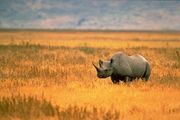Difference between revisions of "Horn"
| Line 2: | Line 2: | ||
== Description == | == Description == | ||
[[File:Mute Cornett 171953.jpg|thumb|]] | [[File:Mute Cornett 171953.jpg|thumb|]] | ||
| − | A hard, semitranslucent, proteinaceous structure that grows from the head of some mammals, such as cattle, sheep, goats, and antelope. Horn, like nails, claws, and hooves, is composed of epidermal cells known as [[keratin]]. Rhinoceros horns are formed from matted [[hair]]. The | + | (anatomy) A hard, semitranslucent, proteinaceous structure that grows from the head of some mammals, such as cattle, sheep, goats, and antelope. Horn, like nails, claws, and hooves, is composed of epidermal cells known as [[keratin]]. Rhinoceros horns are formed from matted [[hair]]. The colors of horn range from a light cream to brown to black. Horn can be cut, engraved, or carved, and has been used since ancient times for tools and ornamentation. The [[thermoplastic]] material is softened with steam or boiling [[water]] then pressed into numerous shapes. In the 18th century, London was the center of the horn molding industry, primarily making snuff boxes and decorative containers. The [[antler|antlers]] of deer are not horns but rather fast growing bones. |
[[File:blackrhinowp2.jpg|thumb|Black rhinocerous]] | [[File:blackrhinowp2.jpg|thumb|Black rhinocerous]] | ||
== Synonyms and Related Terms == | == Synonyms and Related Terms == | ||
| Line 10: | Line 10: | ||
== Physical and Chemical Properties == | == Physical and Chemical Properties == | ||
| − | Will swell slowly in water. | + | * Will swell slowly in water |
| + | * Semi-transparent to opaque | ||
| + | * Fracture = uneven to splintery | ||
| + | * Luster = resinous to vitreous | ||
| + | * Fluorescence = variable | ||
| + | * Birefringence = none | ||
| + | * Inclusions = undulating and fibrous structures | ||
| + | |||
| + | {| class="wikitable" | ||
| + | |- | ||
| + | ! scope="row"| Density | ||
| + | | 1.70 - 1.85 g/ml | ||
| + | |- | ||
| + | ! scope="row"| Refractive index | ||
| + | | 1.560 | ||
| + | |-} | ||
== Resources and Citations == | == Resources and Citations == | ||
* J.Thornton, "The Structure of Ivory and Ivory Substitutes", AIC Preprints, Philadelphia, 1981, p.173-181 | * J.Thornton, "The Structure of Ivory and Ivory Substitutes", AIC Preprints, Philadelphia, 1981, p.173-181 | ||
| − | + | * Gem Identification Lab Manual, Gemological Institute of America, 2016. | |
* ''The Dictionary of Art'', Grove's Dictionaries Inc., New York, 1996 Comment: F.Minney "Horn" p.763 | * ''The Dictionary of Art'', Grove's Dictionaries Inc., New York, 1996 Comment: F.Minney "Horn" p.763 | ||
| − | + | * Wikipedia: [https://en.wikipedia.org/wiki/Horn_(anatomy) Horn (anatomy)] Accessed Dec 2022 | |
* F. Kidd, ''Brushmaking Materials'', Bristish Brush Manufacturers, London, 1957 Comment: p. 142 on handles | * F. Kidd, ''Brushmaking Materials'', Bristish Brush Manufacturers, London, 1957 Comment: p. 142 on handles | ||
| − | |||
* ''Caring for your Collections'', Arthur W Schulz (ed.), Harry N. Abrams, Inc. , New York, 1992 | * ''Caring for your Collections'', Arthur W Schulz (ed.), Harry N. Abrams, Inc. , New York, 1992 | ||
| − | |||
* Tom Rowland, Noel Riley, ''A-Z Guide to Cleaning, Conserving and Repairing Antiques'', Constable and Co., Ltd., London, 1981 | * Tom Rowland, Noel Riley, ''A-Z Guide to Cleaning, Conserving and Repairing Antiques'', Constable and Co., Ltd., London, 1981 | ||
| − | |||
* Oppi Untracht, ''Jewelry Concepts and Technology'', Doubleday & Co., Inc., New York City, 1985 | * Oppi Untracht, ''Jewelry Concepts and Technology'', Doubleday & Co., Inc., New York City, 1985 | ||
| − | |||
[[Category:Materials database]] | [[Category:Materials database]] | ||
Revision as of 13:45, 28 December 2022
Description
(anatomy) A hard, semitranslucent, proteinaceous structure that grows from the head of some mammals, such as cattle, sheep, goats, and antelope. Horn, like nails, claws, and hooves, is composed of epidermal cells known as Keratin. Rhinoceros horns are formed from matted Hair. The colors of horn range from a light cream to brown to black. Horn can be cut, engraved, or carved, and has been used since ancient times for tools and ornamentation. The Thermoplastic material is softened with steam or boiling Water then pressed into numerous shapes. In the 18th century, London was the center of the horn molding industry, primarily making snuff boxes and decorative containers. The antlers of deer are not horns but rather fast growing bones.
Synonyms and Related Terms
cuerno (Esp.); corne (Fr.); chiffre (Port.); Horn (Deut.)
Physical and Chemical Properties
- Will swell slowly in water
- Semi-transparent to opaque
- Fracture = uneven to splintery
- Luster = resinous to vitreous
- Fluorescence = variable
- Birefringence = none
- Inclusions = undulating and fibrous structures
Resources and Citations
- J.Thornton, "The Structure of Ivory and Ivory Substitutes", AIC Preprints, Philadelphia, 1981, p.173-181
- Gem Identification Lab Manual, Gemological Institute of America, 2016.
- The Dictionary of Art, Grove's Dictionaries Inc., New York, 1996 Comment: F.Minney "Horn" p.763
- Wikipedia: Horn (anatomy) Accessed Dec 2022
- F. Kidd, Brushmaking Materials, Bristish Brush Manufacturers, London, 1957 Comment: p. 142 on handles
- Caring for your Collections, Arthur W Schulz (ed.), Harry N. Abrams, Inc. , New York, 1992
- Tom Rowland, Noel Riley, A-Z Guide to Cleaning, Conserving and Repairing Antiques, Constable and Co., Ltd., London, 1981
- Oppi Untracht, Jewelry Concepts and Technology, Doubleday & Co., Inc., New York City, 1985
| Density | 1.70 - 1.85 g/ml |
|---|---|
| Refractive index | 1.560 |


